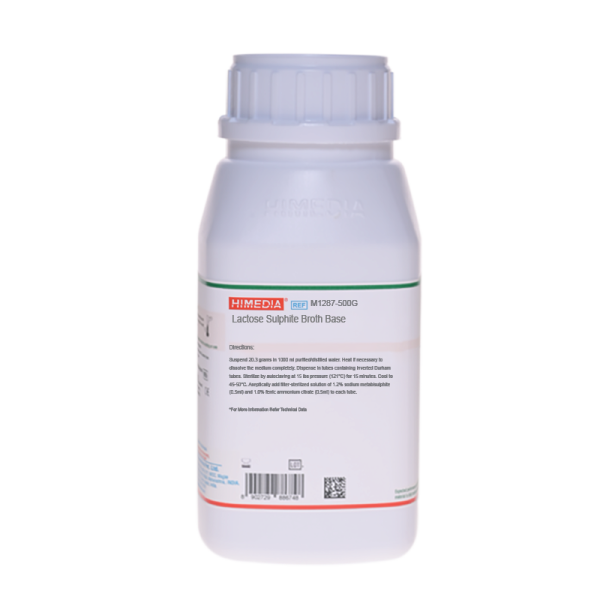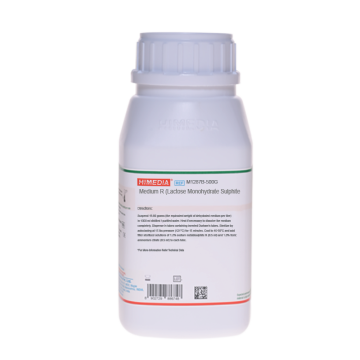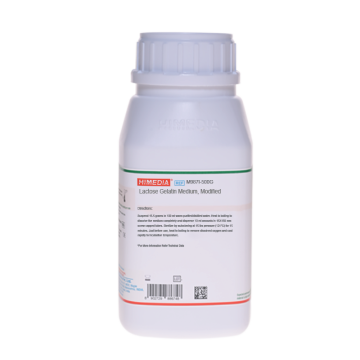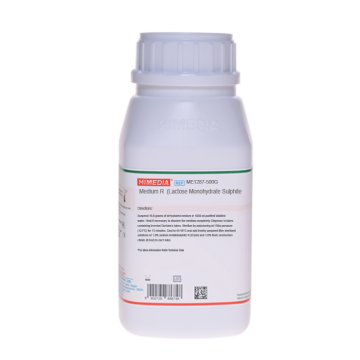 Your enquiry has been submitted
Your enquiry has been submitted
Lactose Sulphite Broth Base
Clostridia#CC293D
Intended Use
Recommended for detection and enumeration of Clostridium perfringens in pharamaceutical products.
Composition**
| Ingredients | Gms / Litre |
|---|---|
| Tryptone | 5.000 |
| Yeast extract | 2.500 |
| Sodium chloride | 2.500 |
| Lactose | 10.000 |
| L-Cysteine hydrochloride | 0.300 |
Final pH (at 25°C): 7.1±0.2
**Formula adjusted, standardized to suit performance parameters
Directions
Suspend 20.3 grams in 1000 ml purified / distilled water. Heat if necessary to dissolve the medium completely. Dispense in tubes containing inverted Durham's tubes. Sterilize by autoclaving at 15 lbs pressure (121°C) for 15 minutes. Cool to 45-50°C and add filter-sterilized solution of 1.2% sodium metabisulphite (0.5ml) and 1.0% ferric ammonium citrate (0.5ml) to each tube.
Principle And Interpretation
Clostridial species are one of the major causes of food poisoning/ gastro-intestinal illnesses. They are gram-positive, spore-forming rods that occur naturally in soil (3). Clostridium perfringens are commonly found in wound infections and diarrhoea cases. The use of toxins to damage the host is a method deployed by many bacterial pathogens. The major virulence factor of C. perfringens is the CPE enterotoxin, which is secreted upon invasion of the host gut, and contributes to food poisoning and other gastrointestinal illnesses (2). Lactose Sulphite Broth Base is formulated as per the European Pharmacopoeia (4th Edition) (3). This medium is useful in semi-quantitative test for presence of C. perfringens in pharmaceutical products where the level of this species is a criterion of quality (1). The medium contains tryptone and yeast extract, which provide essential nitrogenous compounds for Clostridia. Lactose serves as a carbon or fermentable carbohydrate source. Gas production formed due to fermentation gets trapped in the inverted Durhams tubes. Cysteine hydrochloride provides reduced conditions. Sodium metabisulphite and ferric ammonium citrate act as indicators of sulphite reduction, indicated by blackening of the medium. Refer appropriate references for standard procedures (3).
Type of specimen
Food samples; Pharmaceutical samples.
Specimen Collection and Handling:
For pharmaceutical samples follow appropriate techniques for handling specimens as per established guidelines (5,6). For food samples, follow appropriate techniques for sample collection and processing as per guidelines (7). After use, contaminated materials must be sterilized by autoclaving before discarding.
Warning and Precautions :
Read the label before opening the container. Wear protective gloves/protective clothing/eye protection/ face protection. Follow good microbiological lab practices while handling specimens and culture. Standard precautions as per established guidelines should be followed while handling specimens. Safety guidelines may be referred in individual safety data sheets.
Limitations :
- Further biochemical and serological tests must be carried out for further identification.
Performance and Evaluation
Performance of the medium is expected when used as per the direction on the label within the expiry period when stored at recommended temperature.
Quality Control
Appearance Cream to yellow homogeneous free flowing powder
Colour and Clarity of prepared medium Light amber coloured, clear solution without any precipitate
Reaction Reaction of 2.03% w/v aqueous solution at 25°C. pH : 7.1±0.2
pH 6.90-7.30
Cultural Response Cultural characteristics after an incubation at 46±0.5°C for 24-48 hours.
| Organism | Inoculum (CFU) | Growth | H2S | Gas |
|---|---|---|---|---|
| Clostridium perfringens ATCC 12924 | 50-100 | luxuriant | positive reaction, blackening of medium | positive reaction |
| Clostridium perfringens ATCC 13124 (00007*) | 50-100 | luxuriant | positive reaction, blackening of medium | positive reaction |
| Clostridium sporogenes ATCC 19404 (00008*) | 50-100 | luxuriant | negative reaction | positive reaction |
| Clostridium sporogenes ATCC 11437 | 50-100 | luxuriant | negative reaction | positive reaction |
Key: *Corresponding WDCM numbers.
Storage and Shelf Life
Store between 10-30°C in a tightly closed container and the prepared medium at 15-25°C. Use before expiry date on the label. On opening, product should be properly stored dry, after tightly capping the bottle in order to prevent lump formation due to the hygroscopic nature of the product. Improper storage of the product may lead to lump formation. Store in dry ventilated area protected from extremes of temperature and sources of ignition. Seal the container tightly after use. Product performance is best if used within stated expiry period.
Disposal
User must ensure safe disposal by autoclaving and/or incineration of used or unusable preparations of this product. Follow established laboratory procedures in disposing of infectious materials and material that comes into contact with sample must be decontaminated and disposed of in accordance with current laboratory techniques (5,6).
Reference
- British Pharmacopoeia, 2004, The Stationery office British Pharmacopoeia.
- Czeczulin J. R., Hanna P. C., Mcclane B. A., 1993, Infect. Immun., 61: 3429-3439.
- European Pharmacopoeia, 2002, Suppl.4.2. (2001). Chp. 2.6.13, 4th Ed., Council of Europe, Strasbourg
- International Organization for Standardization (ISO), 1997, Draft ISO/DIS 7937:1997.
- Isenberg, H.D. Clinical Microbiology Procedures Handbook 2nd Edition.
- Jorgensen, J.H., Pfaller, M.A., Carroll, K.C., Funke, G., Landry, M.L., Richter, S.S and Warnock., D.W. (2015) Manual of Clinical Microbiology, 11th Edition. Vol. 1.
- Salfinger Y., and Tortorello M.L. Fifth (Ed.), 2015, Compendium of Methods for the Microbiological Examination of Foods, 5th Ed., American Public Health Association, Washington, D.C.
| Product Name | Lactose Sulphite Broth Base |
|---|---|
| SKU | M1287 |
| Product Type | Regular |
| Physical Form | Powder |
| Origin | Animal |
| Packaging type | HDPE |
| References | 1. European Pharmacopoeia, 2002, Suppl.4. |
| Customized Product Available | No |







